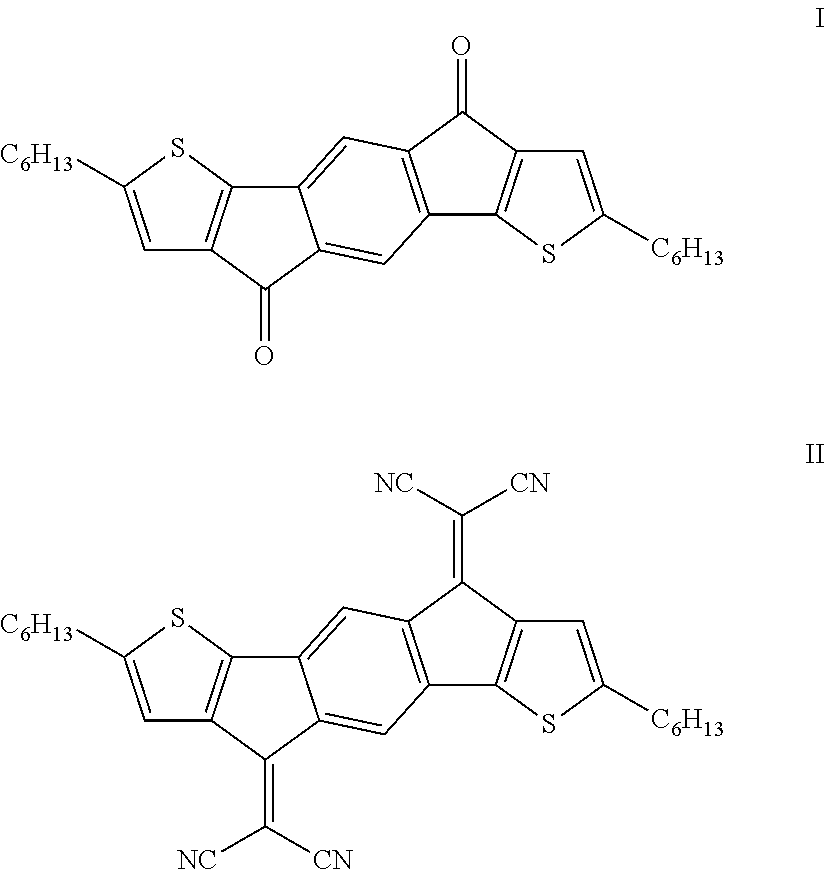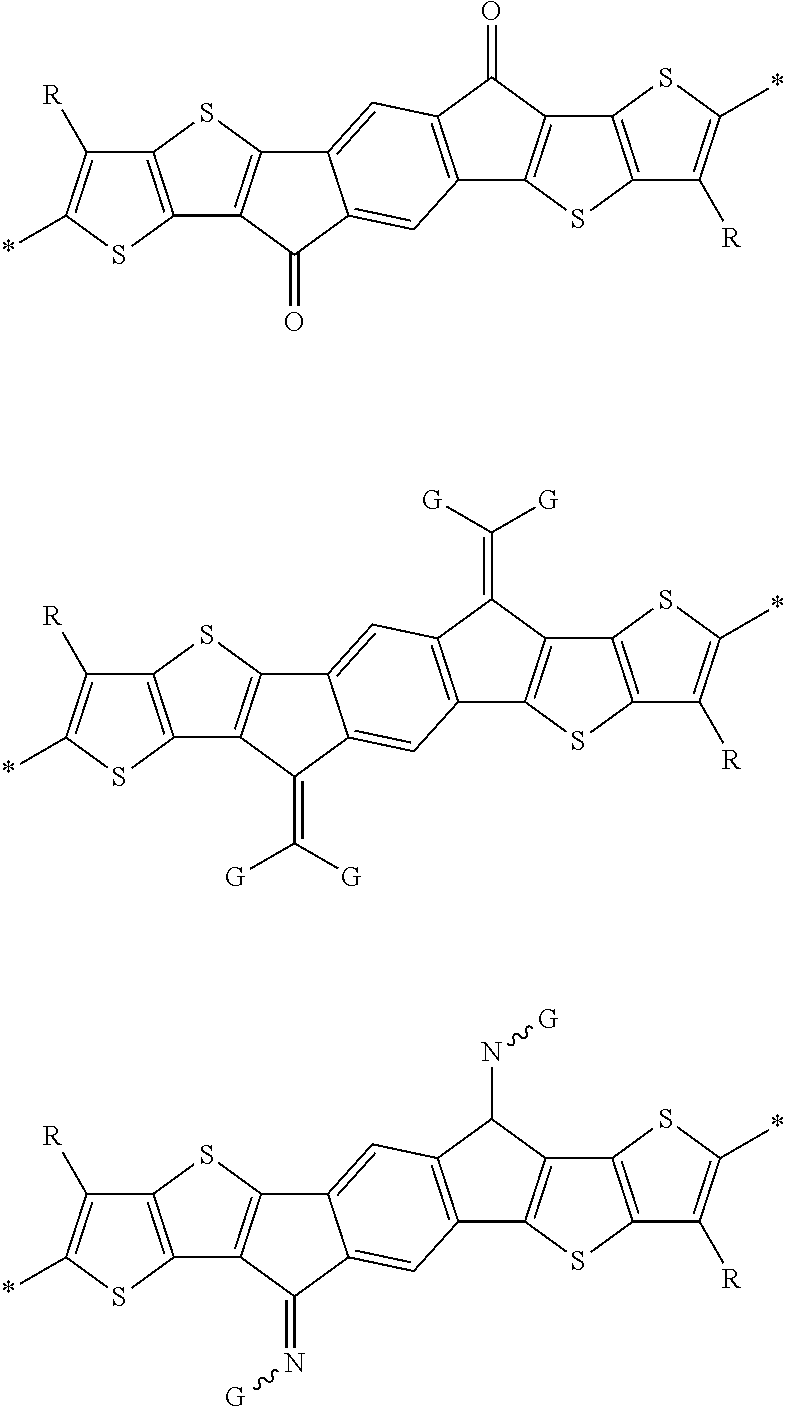Organic semiconductors
- Summary
- Abstract
- Description
- Claims
- Application Information
AI Technical Summary
Benefits of technology
Problems solved by technology
Method used
Image
Examples
example 1
The monomer 2,8-Dibromo-3,9-bis(1-heptyldecyl)IDTT-6,12-dione (11) was Prepared as Described Below
2-Heptylundecanoyl chloride (2)
[0279]To a solution of 2-heptylundecanoic acid (50.0 cm3; 146.94 mmol) and DMF (0.5 cm3) in dry dichloromethane (100 cm3) were added oxalyl dichloride (30 cm3; 354.54 mmol) dropwise over 1 hour. The yellow solution (slightly milky) was stirred at 22° C. for 20 h. The solvent was removed by vacuum evaporation and yellow oil residue was distilled in vacuo (0.27 mBar) at 126-130° C. to yield a pale yellow liquid (43.0 g, 97%). The product was used directly for the subsequent reaction.
3,4-Dibromothienyl-2-heptylundecan-1-one (3)
[0280]To a suspension of 3,4-dibromothiophene (12.84 cm3; 115.00 mmol) and AlCl3 (33.7 g; 253.00 mmol) in dry DCM (250 cm3) at −5° C. was added through a syringe 2-heptylundecanoyl chloride (35.0 g; 115.5 mmol) dropwise. The resultant deep orange suspension was stirred with cooling for 1 hour then hydrolysed by pouring into crunched ice...
example 2
Poly[3,9-bis(1-heptyldecyl)IDTT-6,12-dione-alt-2,5-thieno[3,2-b]thiophenylene] was Prepared as Described Below
[0299]
[0300]The mixture of 2,8-dibromo-3,9-bis(1-heptyldecyl)IDTT-6,12-dione (11) (520.610 mg; 0.50 mmol), 2,5-bis(trimethylstannyl)thieno[3,2-b]thiophene (232.920 mg; 0.50 mmol), Pd(PPh3)2Cl2 (11.500 mg; 0.02 mmol) and anhydrous toluene (10 cm3) was degassed by bubbling nitrogen for 1 hour in a Schlenk tube. The tube was sealed then stirred at 100° C. for 17 hours to yield a yellow-brown slurry. The tube was lifted from the oil-bath and cooled naturally for 5 min followed by the addition of 2-iodothiophene (0.25 ml). The mixture was stirred at 100° C. for 1 hour followed by the addition of toluene (5 cm3). The mixture was stirred at 100° C. for an additional 1 hour. The yellow-brown viscous solution was precipitated into stirred methanol (300 cm3). The solid precipitate was collected by suction filtration and washed with methanol then subjected to Soxhelet extraction with a...
example 3
Poly[3,9-bis(1-heptyldecyl)IDTT-6,12-dione-alt-2,2′-dithiophen-5,5′-ylene] was Prepared as Described Below
[0301]
[0302]In analogy to the synthesis of Example 2, a mixture of 2,8-dibromo-3,9-bis(1-heptyldecyl)IDTT-6,12-dione (11) (520.610 mg; 0.50 mmol), 5,5′-bis(trimethylstannanyl)[2,2]bithiophene (245.938 mg; 0.50 mmol), Pd(PPh3)2Cl2 (11.500 mg; 0.02 mmol) in toluene (9.0 cm3) and DMF (1.0 cm3) was degassed for 1 h then stirred at 110° C. for 2 h to yield a viscous brown-green solution. Bromobenzene (0.1 cm3; 0.95 mmol) was added at this stage and the mixture was stirred at 110° C. for an additional 1 hour prior to the addition of tributylphenylstannane (0.4 cm3; 1.23 mmol). The brown green mixture was stirred for another hour then cooled to rt and precipitated into stirred methanol (250 cm3). The brownish polymer solid was collected by suction filtration and washed with methanol then with acetone. The polymer was purified by Soxhlet extraction with acetone, petroleum ether (40-60),...
PUM
| Property | Measurement | Unit |
|---|---|---|
| Electrical conductor | aaaaa | aaaaa |
| Transport properties | aaaaa | aaaaa |
| Light | aaaaa | aaaaa |
Abstract
Description
Claims
Application Information
 Login to view more
Login to view more - R&D Engineer
- R&D Manager
- IP Professional
- Industry Leading Data Capabilities
- Powerful AI technology
- Patent DNA Extraction
Browse by: Latest US Patents, China's latest patents, Technical Efficacy Thesaurus, Application Domain, Technology Topic.
© 2024 PatSnap. All rights reserved.Legal|Privacy policy|Modern Slavery Act Transparency Statement|Sitemap



